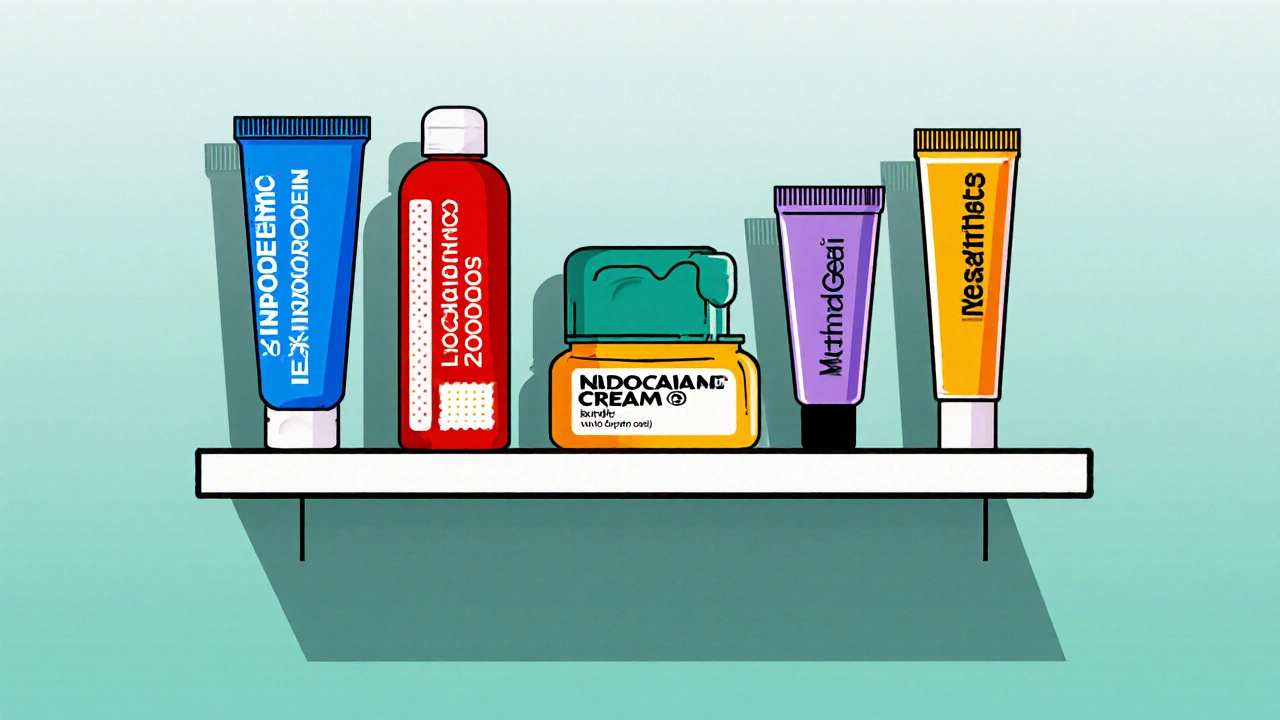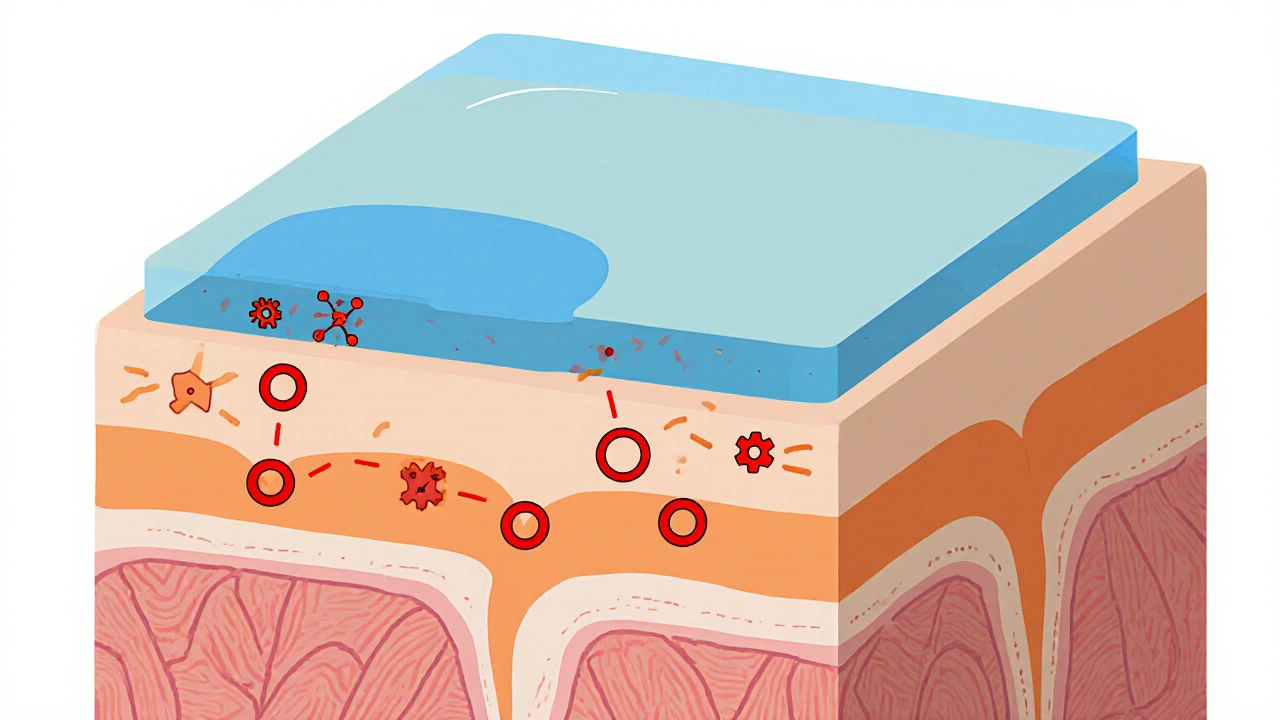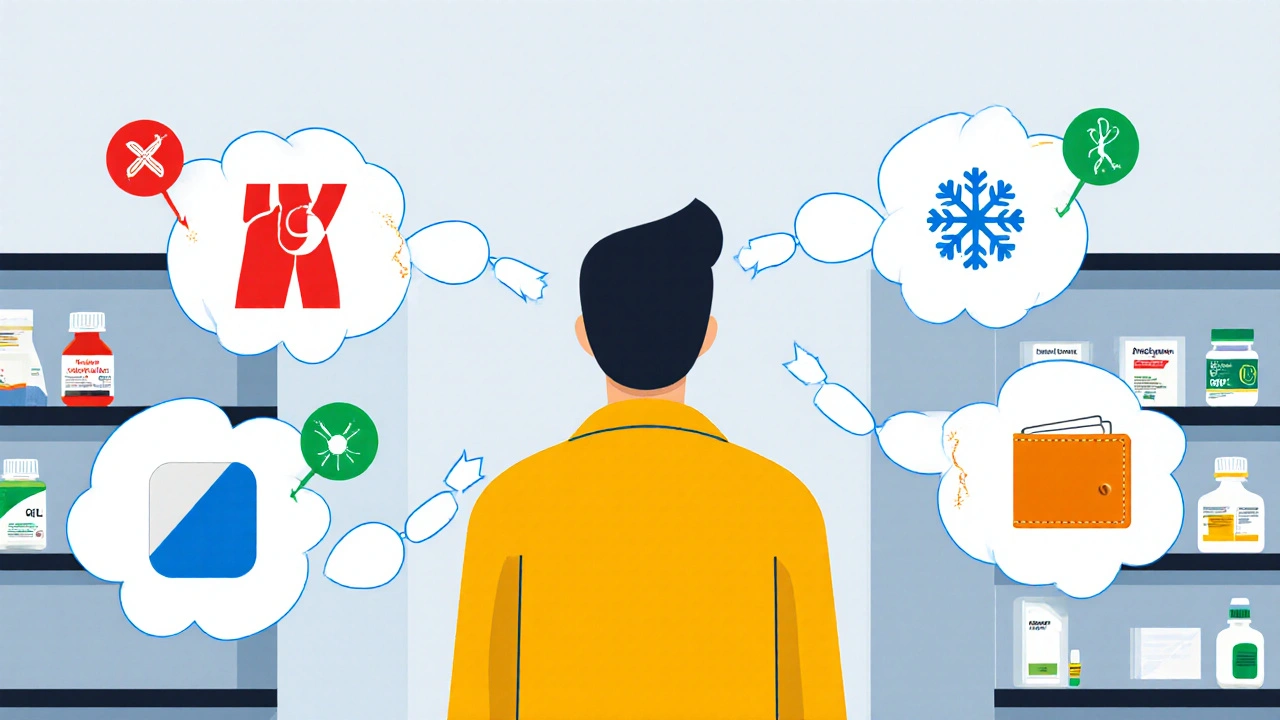Diclofenac Gel vs. Topical Pain Relievers: Pros, Cons & Alternatives
 Oct, 17 2025
Oct, 17 2025
Topical Pain Reliever Selector
Select your pain type and preferences to find the most suitable topical pain reliever for your condition.
Quick Takeaways
- Diclofenac Gel offers fast relief for joint and muscle pain but can cause skin irritation.
- Ibuprofen Gel and Naproxen Cream are similar NSAID options with slightly different dosing and side‑effect profiles.
- Lidocaine patches and Capsaicin creams work via nerve desensitization rather than inflammation reduction.
- Menthol and methyl salicylate products provide a cooling sensation but lack strong anti‑inflammatory action.
- Choose the right product based on pain type, skin sensitivity, cost, and duration of use.
How Diclofenac Gel Works
When you need quick, localized pain relief, Diclofenac Gel is often the first name that pops up. It belongs to the family of topical non‑steroidal anti‑inflammatory drugs (NSAIDs). The gel delivers the active ingredient straight to the skin, where it penetrates the underlying tissue and blocks the cyclooxygenase (COX) enzymes that produce prostaglandins - the chemicals that drive inflammation and pain.
Diclofenac Gel is a topical NSAID formulated at 1% or 3% concentration to treat musculoskeletal pain, osteoarthritis, and soft‑tissue injuries. By acting locally, it avoids the higher systemic exposure associated with oral NSAIDs, which means fewer stomach and cardiovascular risks for most users.
Key Alternatives and How They Differ
Not every pain scenario calls for Diclofenac Gel. Below are the most common topicals you’ll see on pharmacy shelves and what makes each unique.
Ibuprofen Gel is a 5% topical NSAID that offers a similar anti‑inflammatory effect to diclofenac but with a slightly faster onset for mild to moderate pain. It’s often recommended for athletes because it’s gentle on the skin.
Naproxen Cream is a prescription‑only topical NSAID, typically at 1% concentration, prized for its longer half‑life, which can provide relief for up to 12 hours. It’s a solid choice for chronic conditions like rheumatoid arthritis.
Lidocaine Patch is a 5% local anesthetic patch that numbs the skin by blocking sodium channels in nerve fibers. It doesn’t reduce inflammation but can be a lifesaver for localized neuropathic pain.
Capsaicin Cream is a high‑dose (0.075%-0.1%) topical derived from chili peppers that desensitizes pain receptors over time. It requires daily application for weeks before noticeable relief.
Menthol Gel is a cooling analgesic that activates TRPM8 receptors, delivering a soothing sensation rather than true anti‑inflammatory action. Ideal for minor strains or as an adjunct to stronger agents.
Ketoprofen Gel is a topical NSAID with a 2.5% concentration, used in Europe for sports‑related injuries; it offers strong pain control but is less common in Australia.
Methyl Salicylate is the active component in many “rub‑away” ointments, providing a warming effect by stimulating blood flow. It's more of a symptomatic comfort measure than a deep anti‑inflammatory.
When to Choose Diclofenac Gel Over Alternatives
- Inflammatory pain: If swelling is the main driver (e.g., ankle sprain, gout flare), a NSAID gel works best.
- Short‑term use: For a course of up to two weeks, Diclofenac Gel’s safety profile is well‑documented.
- Skin tolerance: People who tolerate Diclofenac’s 1% formulation but react to menthol’s cooling effect may prefer it.
- Cost considerations: Over‑the‑counter 1% Diclofenac is usually cheaper than prescription‑only Naproxen Cream.
If you have a history of ulcers, cardiovascular disease, or are on anticoagulants, discuss any NSAID use-topical or oral-with your healthcare provider.

Potential Risks and How to Minimize Them
While the systemic risks of topical NSAIDs are low, local side effects can be a deal‑breaker.
- Skin irritation: Redness, itching, or a burning sensation may occur, especially with the 3% formulation. Apply a thin layer and avoid broken skin.
- Allergic reaction: Rare, but if you develop hives or swelling, stop use immediately and seek medical advice.
- Interaction with other NSAIDs: Using oral ibuprofen or aspirin alongside a topical NSAID can increase overall exposure; stagger applications if needed.
Always wash your hands after applying and keep the product away from eyes, mouth, and mucous membranes.
Practical Comparison Table
| Product | Active Ingredient | Typical Concentration | Primary Indication | Onset of Relief | Common Side Effects | Approx. Cost (AU$) |
|---|---|---|---|---|---|---|
| Diclofenac Gel | Diclofenac Sodium | 1% (OTC) / 3% (Prescription) | Joint/muscle pain, osteoarthritis | 15-30 min | Skin irritation, itching | 7-12 (OTC 1%) |
| Ibuprofen Gel | Ibuprofen | 5% | Acute sprains, minor arthritis | 10-20 min | Mild burning, dryness | 10-15 |
| Naproxen Cream | Naproxen | 1% | Chronic inflammatory conditions | 30-45 min | Redness, rare systemic NSAID effects | 20-30 (prescription) |
| Lidocaine Patch | Lidocaine | 5% (patch) | Localized neuropathic pain | 1-2 hrs | Skin numbness, rare systemic toxicity | 25-35 (per patch) |
| Capsaicin Cream | Capsaicin | 0.075%-0.1% | Chronic pain, neuropathy | Days to weeks | Burning, tingling | 15-20 |
| Menthol Gel | Menthol | 2%-4% | Minor strains, sore muscles | Immediate | Cooling sensation, occasional irritation | 5-8 |
| Ketoprofen Gel | Ketoprofen | 2.5% | Sports injuries, tendonitis | 20-35 min | Skin redness, itching | 12-18 (EU market) |
| Methyl Salicylate Ointment | Methyl Salicylate | 10%-30% | Heat‑induced relief, superficial aches | Immediate | Warmth, possible dermatitis | 4-6 |
Choosing the Right Product: A Decision Flow
Use this quick mental checklist before you reach for the bottle:
- Is the pain driven by inflammation? → Pick a topical NSAID (Diclofenac, Ibuprofen, Naproxen).
- Do you need a numbing effect without anti‑inflammation? → Go for Lidocaine Patch.
- Are you managing chronic neuropathic pain and have time for gradual desensitization? → Capsaicin Cream.
- Do you prefer a cooling or warming sensation for a mild ache? → Menthol Gel or Methyl Salicylate.
- Budget constraints? → OTC Diclofenac 1% or Menthol Gel are the cheapest options.

Frequently Asked Questions
Frequently Asked Questions
Can I use Diclofenac Gel on broken skin?
No. Applying any topical NSAID on open wounds can increase systemic absorption and cause irritation. Stick to intact skin only.
How long can I safely use Diclofenac Gel?
Most guidelines suggest a maximum of two weeks for continuous use unless a doctor advises otherwise.
Is Diclofenac Gel safer than oral NSAIDs?
Yes, because the drug stays mostly local, the risk of stomach ulcers and cardiovascular events is much lower than with oral tablets.
Can I combine Diclofenac Gel with an oral painkiller?
Occasionally, doctors recommend a low‑dose oral acetaminophen alongside a topical NSAID for added relief, but avoid stacking multiple NSAIDs.
What’s the main difference between Ibuprofen Gel and Diclofenac Gel?
Ibuprofen Gel usually comes at a higher concentration (5%) and may feel less irritating, while Diclofenac Gel is available over‑the‑counter at 1% and has a slightly longer track record for joint pain.
Final Thoughts
Choosing a topical pain reliever isn’t one‑size‑fits‑all. Diclofenac Gel shines when you need a fast, anti‑inflammatory kick for a sprain or arthritis flare, but it isn’t the answer for nerve‑related burning or for those with skin sensitivities. By matching the medication’s mechanism to your specific pain type, you’ll get more relief with fewer side effects-and maybe even save a few bucks while you’re at it.

Joanna Mensch
October 17, 2025 AT 18:20The thing they don’t tell you is that the gel is a delivery system for chemicals that can quietly accumulate in your bloodstream. Big Pharma loves the idea of a “local” painkiller because it sidesteps the scary headlines about heart attacks. Every time you rub that slick layer on, a tiny percentage slips past the skin barrier and joins the systemic pool. If you have a hidden ulcer or are on blood thinners, that silent drift could be the spark for a disaster. So read the fine print and keep an eye on any unusual skin reactions.
RJ Samuel
October 17, 2025 AT 18:53Honestly, the hype around Diclofenac gel feels a bit overblown, like a circus parade for a mediocre performer. Ibuprofen gel hits the spot faster and usually leaves the skin less irritated, which is a pleasant surprise for anyone with sensitive arms. The 5% concentration means you get a punch of relief without the dreaded sticky feel that Diclofenac sometimes brings. Plus, the price tag on the over‑the‑counter version often undercuts the ‘prescription‑grade’ 3% gel. In short, if you’re looking for a quick fix without the drama, reach for the ibuprofen tube.
Nickolas Mark Ewald
October 17, 2025 AT 19:26Both gels work by reducing inflammation right where you need it, so they’re great for joint aches and sprains. The main difference is the concentration: Diclofenac is usually 1% OTC, while ibuprofen comes at 5% and feels a bit smoother. If your skin gets red or itchy, try the lower‑strength Diclofenac first and see how you react. For a faster onset, ibuprofen often kicks in within ten minutes. Overall, they’re both solid choices depending on your tolerance and budget.
Chris Beck
October 17, 2025 AT 20:16Look lads this is just another American‑made pain cream trying to steal the market from proper UK remedies. The Brits have been using menthol and rub‑aways for ages, no need for a fancy gel that promises miracles. Diclofenac? More like a marketing gimmick with a price tag to match. If you want something that actually works, get a good old hot water bottle and a proper rest. Stop chasing the hype and trust what’s been proven.
Emily Rankin
October 17, 2025 AT 21:06Pain, in its relentless whisper, reminds us that we are still alive, feeling, and moving through this fleeting world. When a targeted gel like Diclofenac eases that burden, it feels almost poetic-a brief lull in the storm of sensation. Yet, we must remember that each relief carries a responsibility to listen to our bodies, not just silence them. Embrace the moments of comfort, but let them inspire gratitude for the small miracles of modern science. In the grand theatre of life, even a humble cream can play a heroic role.
Rebecca Mitchell
October 17, 2025 AT 21:40I tried the 1% gel once after a marathon and it barely tingled but the skin stayed calm. If you’re looking for a gentle option, stick with the low concentration and apply a thin layer.
Roberta Makaravage
October 17, 2025 AT 23:03Let’s get something straight: the market for topical NSAIDs is a battlefield of convenience versus conscience. First, the chemistry of diclofenac is designed to infiltrate the skin barrier, delivering a potent anti‑inflammatory punch that can mask pain without addressing the root cause. Second, the allure of a quick fix often blinds consumers to the ethical implications of supporting pharmaceutical giants whose profit motives eclipse patient wellbeing. Third, these gels, while locally acting, still contribute to the cumulative NSAID load in our bodies, potentially stressing kidneys and the cardiovascular system over time. Fourth, the advertising machinery paints a picture of safety that ignores rare but serious skin reactions, like dermatitis and contact allergies. Fifth, when you compare the cost‑effectiveness of a 1% OTC gel to a simple home remedy-ice packs, gentle stretching, and proper ergonomics-you’ll see that the latter wins on both health and wallet fronts. Sixth, the reliance on such creams can foster a culture of pharmacological dependence, reducing the incentive to explore holistic pain management strategies such as yoga, acupuncture, or dietary adjustments. Seventh, the environmental impact of mass‑produced gels-plastic tubes, chemical runoff, and carbon‑intensive manufacturing-cannot be dismissed in an era where sustainability should be a priority. Eighth, the social narrative that equates pain relief with personal strength often pressures individuals to mask discomfort rather than seek comprehensive care. Ninth, the dichotomy between “OTC” and “prescription‑only” versions is a thin veil over a profit‑driven gradient, nudging patients toward higher‑priced options with marginal benefit. Tenth, we must ask: are we treating symptoms or perpetuating a cycle of dependency? Eleventh, the regulatory oversight for topical formulations is sometimes lax, allowing products with varying concentrations and purity levels to flood the market. Twelfth, the mental health aspect-reliance on a cream for constant pain relief-can exacerbate anxiety and lower self‑efficacy. Thirteenth, a balanced approach would involve using the gel sparingly, under professional guidance, while integrating non‑pharmacologic therapies. Fourteenth, education is key: patients should be fully informed about both the benefits and risks, not just the marketing blurbs. Fifteenth, in the grand scheme, a mindful, informed, and less‑chemical‑dependent path to pain management not only respects our bodies but also upholds a broader ethical responsibility. 🌱💊🧠
Lauren Sproule
October 18, 2025 AT 00:26Hey folks, just wanted to drop a quick note that there’s no one‑size‑fits‑all when it comes to these gels. If you have sensitive skin, the 1% diclofenac or a menthol gel can be a good starting point-just test a tiny area first. For folks on a budget, the OTC options usually beat the prescription creams by a mile. And remember, rotating between a NSAID gel and a non‑drug option like a warm compress can keep things fresh and reduce irritation. Stay safe and definatly listen to your body’s signals!
CHIRAG AGARWAL
October 18, 2025 AT 01:00Meh just another cream.